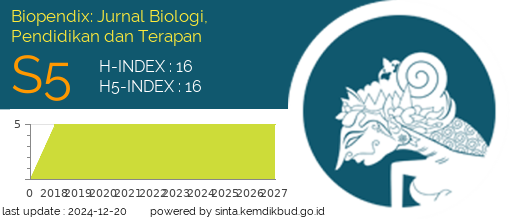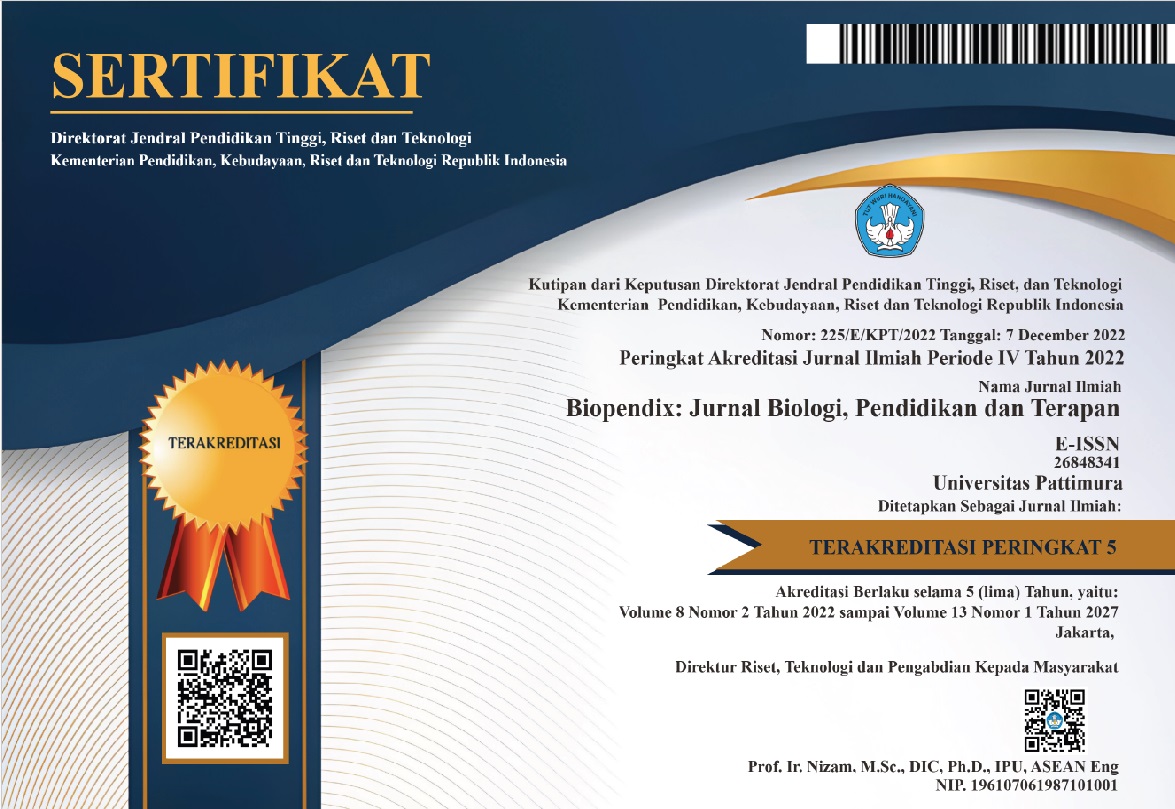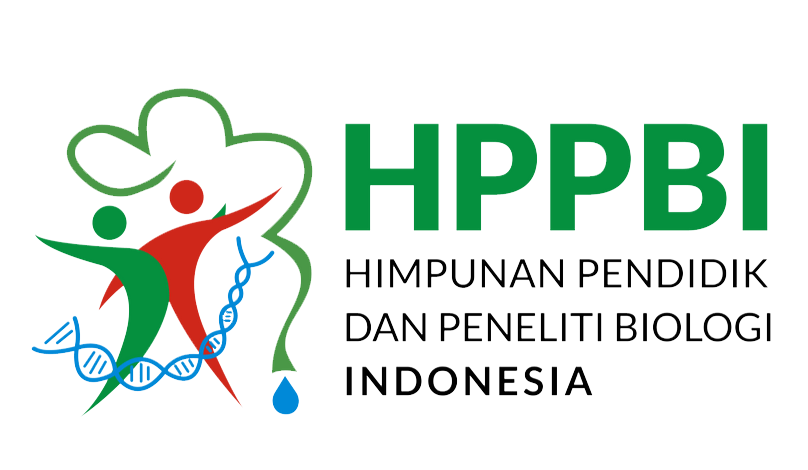ANALISIS KADAR PROTEIN CACING LAOR (POLYCHAETA) DARI PERAIRAN PULAU AMBON
Abstract
Background: Laor is a variety of types of marine worms (Polychaeta) that appear periodically in large numbers at sea level at any given time and consumed by the Ambon island community. Environmental factors that affect Laor's presence are light, salinity, and temperature. Laor lives on a rocky substrate such as those found in the waters of the village of Latuhalat, the village of Allang, and the village of Hutumuri.
Method: The method used to analyze the protein content of Laor worm is Kjedhal method and the data is analyzed with nonparametric statistic, and if different then further test is done by using LSD (Least Significance Difference) test.
Results: At the time of Laor sampling in the village of Latuhalat, Allang village, and Hutumuri village, wavy surface conditions, water in low tide, the weather is sunny, and the three villages have sandy coral substrate. While the environmental chemical physics factor in Latuhalat village shows salinity is 33o / â—‹â—‹, temperature is 30oC, and pH is 5.23. Allang Village has a salinity of 30o / â—‹â—‹, a temperature of 29oC, and a pH of 7.55. The village of Hutumuri has a salinity of 32o / â—‹â—‹, a temperature of 28oC, and a pH of 5.50. The results of protein content analysis showed that the average Laor protein level from Latuhalat village was 14.293%, Allang village 15.0497%, and Hutumuri village 10.952%. While the average protein level in Laor worms showed Laor worm protein levels from each village were significantly different.
Conclusion: The average of Laor worm protein from Ambon Island waters is significantly different from that of Latuhalat 14.293%, alang 15.0497% village, and Hutumuri village 10.952%. The average Laor worm protein level tested with parametric statistic showed Laor worm protein levels from each village were significantly different.
Downloads
References
Miller, C. D. & Pen, F., Composition and nutritive Value of Palolo. Pacific Science, 1959, 13, 191-194.
Nybakken, J. W., 1992. Biologi Laut Suatu Pendekatan Ekologis. Gramedia, Jakarta, 1992, 334.
Pamungkas, J.(a), Pengamatan Jenis Cacing Laor (Annelida, Polychaeta) di Perairan Desa Latuhalat Pulau Ambon, dan Aspek Reproduksinya, Jurnal Triton, 2009, 5, 2, 1-10.
Pamungkas, J.(b), Swarming Cacing Laut Polikhaeta (Annelida) di Indonesia, Jurnal Oseana, 2009, 34, 3, 35-44.
Pamungkas J., Species richness and macronutrient content of wawo worms (Polychaeta, Annelida) from Ambonese waters, Maluku, Indonesia, Biodiversity Data Journal, 2015, 3: e4251. doi: 10.3897/bdj.3.e4251
Radjawane TR., Laor: Cacing Laut Khas Perairan Maluku, Lomba Karya Penelitian Ilmiah Remaja, Jakarta. Departemen Pendidikan dan Kebudayaan Republik Indonesia, Jakarta, 1982, 1- 29.
Savitri, I. R. E., Latumahina, M. Ch. A., & Tapotubun, A. M. Studi Kandungan Gizi Laor. Prosiding Seminar Nasional Perikanan dan Kelautan, Fakultas Perikanan dan Kelautan Universitas Brawijaya Malang, 2008, 154-156.
Tampubolon, K., Purnomo, D., & Sangadji, M. 2007. Pengolahan Pasta Laor (Eunice viridis) dengan berbagai Konsentrasi Garam. Buletin Teknologi Hasil Perikanan, 2007, 10, 1, 47-58.
Yusron, E., Beberapa Catatan Mengenai Cacing Laut (Polychaeta), Jurnal Oseana, 1985, 10, 4, 122-127.
Authors who publish with this Journal agree to the following terms:
- Author retain copyright and grant the journal right of first publication with the work simultaneously licensed under a creative commons attribution license that allow others to share the work within an acknowledgement of the work’s authorship and initial publication of this journal.
- Authors are able to enter into separate, additional contractual arrangement for the non-exclusive distribution of the journal’s published version of the work (e.g. acknowledgement of its initial publication in this journal).
- Authors are permitted and encouraged to post their work online (e.g. in institutional repositories or on their websites) prior to and during the submission process, as it can lead to productive exchanges, as well as earlier and greater citation of published works





 2
2






